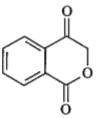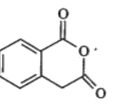Paragraph
An organic compound does not react with aqueous solution of as well as does not change the colour of litmus paper. Aon acid hydrolysis gives as major product whereas A on treatment with one equivalent of methanol in acidic medium gives as the major product (other minor isomer of C is also formed). B on heating with sodalime gives toluene. Answer the following questions based on the above information.
The structure of A satisfying above conditions is Solution in Malayalam




The correct Answer is:C

Here C=O bonded to phenyl ring is more activated for esterification as it produces more stable protonated product.

Topper's Solved these Questions
- CARBOXYLIC ACID & THEIR DERIVATIVESBOOK - BRILLIANT PUBLICATIONCHAPTER - CARBOXYLIC ACID & THEIR DERIVATIVESEXERCISE - LEVEL-III (Statement Type Questions)
6 Videos
- BIOMOLECULES, POLYMERS AND CHEMISTRY IN EVERYDAY LIFE BOOK - BRILLIANT PUBLICATIONCHAPTER - BIOMOLECULES, POLYMERS AND CHEMISTRY IN EVERYDAY LIFE EXERCISE - LEVEL-II (ASSERTION-REASON TYPE QUESTIONS)
6 Videos
- CARBOXYLIC ACIDSBOOK - BRILLIANT PUBLICATIONCHAPTER - CARBOXYLIC ACIDSEXERCISE - LEVEL-II (Assertion -Reason)
4 Videos
Similar Questions
Statement 1 : The melting points and boiling points of aliphatic acids are usually higher than those of aromatic acids of comparable molecular masses.
Statement 2 : The planar benzenering in the aromatic acids can fit more closely in the crystal lattice than zig-zig structure of aliphatic acids.
View SolutionAssertion : Glucose gives a reddish brown precipitate with Fehling's solution.
Reason : Reaction of glucose with Fehling's solution gives CuO and gluconic acid.
View SolutionAssertion : p-chlorobenzoic acid is more acidic than p-fluorobenzoic acid.
Reason : +R effect of fluorine is higher than that of chlorine due to the matching size of carbon and fluorine.
View SolutionAn organic compound (A) (C_(5)H_(7)OCl) reacts rapidly with ethanol to give (B) (C_(7)H_(12)O_(2)) . (A) also reacts with water to produce an acid which reacts with bromine to give (C ) (C_(5)H_(8)Br_(2)O_(2)) . (B) on boiling with H_(2)SO_(4) forms an acid (D). When (D) is oxidised with KMnO_(4) an acid (E ) (C_(4)H_(6)O_(3)) is produced. On mild heating, (E ) gives (F) (C_(3)H_(6)O) which cannot be oxidised by ammoniacal AgNO_(3) . Identify the compounds (A) to (F).
View SolutionAn organic compound (A) C_(6)H_(10) on reduction, first give (B) C_(6)H_(12) and finally (C) C_(6)H_(14) (A) on reaction with ozone followed by hydrolysis is presence of Zn gives two aldehydes C_(2)H_(4)O (D) and C_(2)H_(2)O_(2) (E) Oxdation of (B) with acidified KMnO_(4) gives acid (F) C_(3)H_(6)O_(2) Determine structures of (A) to (F) with proper reasoning.
View SolutionAn organic compound 'A' has molecular formula C_(9)H_(13)NO and it can be resolved into enatiomers. A does not decolourise bromine water solution. A on reflxing with dilute H_(2)SO_(4) yields another resolable compound B(C_(9)H_(14)O_(3)) which gives effervescence with NaHCO_(3) . B on treatemet with NaBH_(4) yields C(C_(9)H_(16)O_(3)) on heating with concentrated H_(2)O_(4) yields ester D(C_(9)H_(14)O_(2)) . Compound A on reduction with LiAIH_(4) , followed by treatement of H_(2)SO_(4) yields following compound: Find out structure of compound 'A' :
View SolutionCompound (A) C8H6O2 on treatment with aq. NaOH followed by acidification gives (B) C8H8O3 which on oxidation gives benzoice acid only :
View SolutionCompound A (C7H7Cl) react with aq. KOH at room temperature and give compound D(C7H8O). Another isomer B gives only one mononitration product on treatment with HNO3+H2SO4 mixture . Isomer C gives comound E(C7H5O2Cl) on heating with KMnO4 solution . E gives 3-chloro-4-nitrobezoic acid as major product . Identify compound D.
View SolutionOn ozonolysis, an organic compound (A) C6H10 gives two aldehyde (B) C2H4O and (C ) C2H2O2. Determine the structure of A,B and C.
View SolutionCompound C_(8)H_(9)Cl (A) on treatment with KICN followedd by hydrolysis gives C_(9) H_(10) O_(2) (B) . Ammonium salt of (B) on dry disillation yiels (C) , wyhich reacts with alkene solution of bromnine to give C_(8) H_(141) N (D) . Another compound C_(8) H_(10) O (E) is obtained by the actions by the action of nitrous acid of (D) or by the action of aqueosu potacsh on (A), (E) on oxidation gives the inner anthydide C_(8) H_(6)O_(4) (F) which gaves the inner anthdride C_(8) H_(4) O_(3) (G) on heating Identify the various compounds (A) to (G) .
View SolutionC2H6O सूत्र वाले कार्बनिक यौगिक (A) को सांद्र H2SO4 के साथ 413 k गर्म करने पर C4H10O सूत्र वाला उदासीन यौगिक (B) प्राप्त होता है। (B) की क्रिया PCl5 से कराने पर एक उत्पाद प्राप्त होता है जिसकी क्रिया KCN के साथ कराने पर C3H5N सूत्र वाला यौगिक (C) प्राप्त होता है। यौगिक (C) जल-अपघटन पर एक अम्ल C3H6O2 देता है तथा Na/Hg द्वारा अपचयन पर एक क्षारक C3H9N देता है। यौगिक (A), (B) तथा (C) क्या हैं? सन्निहित अभिक्रियाएँ भी दीजिए।
View SolutionAn organic compound A(C_(4)H_(8)N_(2)) on hydrolysis in acidic medium gives another compound B(C_(4)H_(9)O_(2)N) . B forms zwitter ion and gives off CO_(2) with NaHCO_(3) . B on heating gives compound C(CH_(4)H_(7)ON).LiAlH_(4) in ether reduces C to pyrolidine. Identify compounds A,B,C.
View SolutionAn organic compound A(C_(6)H_(10)) on reduction first gives B(C_(6)H_(12)) and finally C(C_(6)H_(14)) . Compound A on ozonolysis followed by hydrolysis gives two aldehydes D(C_(2)H_(4)O) and E(C_(2)H_(2)O_(2)) . Oxidation of B with acidified KMnO_(4) gives the acid F(C_(4)H_(8)O_(2)) . determine the structures of the compounds A to F with reasoning.
View SolutionAn organic compound ‘A’ has molecular formula C9H13NO and it can be resolve into enantiomers. Adoes not decolourise bromine water solution. A on refluxing with dilute H2SO4, yields another revolvable compound B(C9H14O3) which give effervescence with NaHCO3. B on treatment with NaBH4 yields C(C9H16O3) on heating with concentrated H2SO4 yields ester D (C6H14O2).
Compound A on reduction with LiAlH4 followed by treatment of H2SO4 yields following compound :

Find out structure of compound 'A''
View SolutionAn organic compound (A) (C_(5)H_(7)OCl) reacts rapidly with ethanol to give (B) (C_(7)H_(12)O_(2)) . (A) also reacts with water to produce an acid which reacts with bromine to give (C ) (C_(5)H_(8)Br_(2)O_(2)) . (B) on boiling with H_(2)SO_(4) forms an acid (D). When (D) is oxidised with KMnO_(4) an acid (E ) (C_(4)H_(6)O_(3)) is produced. On mild heating, (E ) gives (F) (C_(3)H_(6)O) which cannot be oxidised by ammoniacal AgNO_(3) . Identify the compounds (A) to (F).
View SolutionAn organic compound A has molecular formula C10H17Br and it is non-resolvable. A does not decolourise brown colour of bromine water solution. A on treatement with (CH3)2COK/(CH3)3COH yields B as majot product. B on treatment with H2/Pt yields (C10H16) which on treatment with CI2/hv yields three monochloro derivative. Also B on boiling with acidic permanganate solution yields C(C10H16O3)C. on heating with sodalime yields D(C9H16O).D on reducing with LiAIH4 followed by heating product with concentrated H2SO4 yields E(C9H16) as major product. E on treatment with ozone followed by work-up with Zn−H2O yields 6-Ketononanal.
Compound B is:
View Solution
